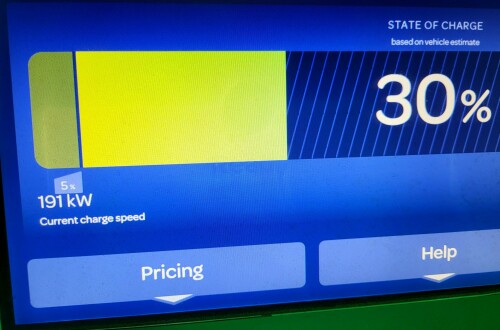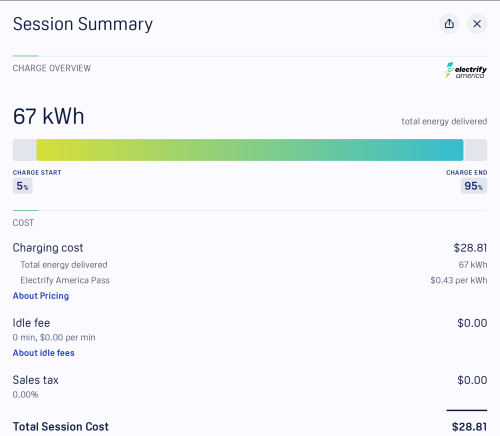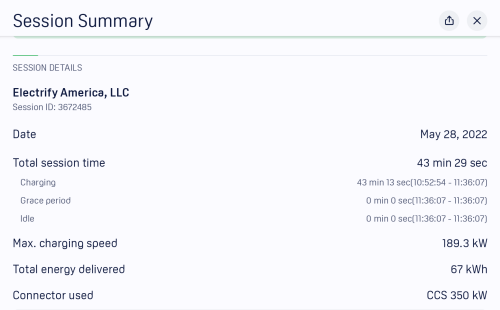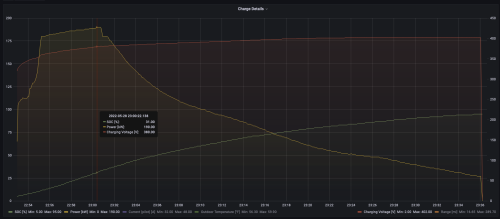Results from the "350 kW" / 500A DCFC session is finally here! 
To test the charging curve, I drove my Model Y on the freeway to discharge the car down to 5% SoC.
My plan was to go to a "350 kW" / 500A EA DCFC nearby. I navigated to a near the EA DCFC to make sure the battery is preconditioned for optimal charging.
I plugged into the EA "350 kW" / 500A station at 5% and charged up to 95% using the Tesla CCS adapter. Charging that last 5% was going to take way too long, and really isn't important for this test.
It added 67 kWh to the battery in 43 mins (5% - 90%).
Total cost was 67 kWh * $0.43/kWh = $28.81
I saw 191 kW peak power dispensed from the DCFC via EA's screen at 30% SoC.

Now onto the nerdy stuff...
Verification of "350 kW" / 500A DCFC via unit label:

Summary receipt from EA after the charging session:

Interesting to note, they do show in the receipt that the "350 kW" CCS connector was used, and dispensed at a max charging speed of 189.3 kW.

And now for the interesting bits, charging data! Captured and graphed by Teslamate.
(Click for high-res charging curve):

The curve is very nice, except for the first 5% (5-10%) it took a bit to ramp up the power. It then followed a rise in power as voltage rose and a natural decaying curve once it hit peak at 30%, expected as the battery becomes full.
Summarizing stats in text form, for convenience:
5%: 105 kW | 327 V | 321 A
10%: 136 kW | 352 V | 386 A
15%: 182 kW | 362 V | 503 A
20%: 185 kW | 371 V | 499 A
25%: 187 kW | 375 V | 499 A
30%: 190 kW | 380 V | 500 A (PEAK POWER!)
40%: 160 kW | 383 V | 418 A
50%: 124 kW | 386 V | 321 A
60%: 102 kW | 390 V | 262 A
70%: 84 kW | 395 V | 213 A
80%: 59 kW | 400 V | 148 A
90%: 41 kW | 402 V | 102 A
95%: 28 kW | 402 V | 70 A
Remember, these are stats that the car is reporting delivered to the battery. So the power dispensed by the DCFC will be slightly higher.
The amperage is not reported in the stats. It was calculated by me manually by dividing the power by the voltage.
I think my test may not have been 100% optimal, as I've screen screen snaps of other members charging at 200+ kW at 500A EA stations (pulling well over 530A from the station). However those may have been an anomaly with the station allowing the car to exceed the CCS spec temporarily? Either way, I don't think I myself could've done any better, I challenge someone else to give it a try at low SoC %!
Another thing we learned here is that the Model Y is a charging beast! What other car charges from 5% to 95% in just 43 mins?
5% to 80% in just 27 mins! And this is on a 500A-capped CCS DCFC. I believe Tesla superchargers go up to 750A for V3 250 kW ones (250 kW / 350V = 714A).
This car just gulps all the amps it can take. Too bad it can't maintain those high amps beyond 30% (cooling deficiency?). Other 500A / 400V cars like the Rivian and EQC peaks at "only" 500A, but can maintain that for much longer than the Model Y.
To test the charging curve, I drove my Model Y on the freeway to discharge the car down to 5% SoC.
My plan was to go to a "350 kW" / 500A EA DCFC nearby. I navigated to a near the EA DCFC to make sure the battery is preconditioned for optimal charging.
I plugged into the EA "350 kW" / 500A station at 5% and charged up to 95% using the Tesla CCS adapter. Charging that last 5% was going to take way too long, and really isn't important for this test.
It added 67 kWh to the battery in 43 mins (5% - 90%).
Total cost was 67 kWh * $0.43/kWh = $28.81
I saw 191 kW peak power dispensed from the DCFC via EA's screen at 30% SoC.

Now onto the nerdy stuff...
Verification of "350 kW" / 500A DCFC via unit label:

Summary receipt from EA after the charging session:

Interesting to note, they do show in the receipt that the "350 kW" CCS connector was used, and dispensed at a max charging speed of 189.3 kW.

And now for the interesting bits, charging data! Captured and graphed by Teslamate.
(Click for high-res charging curve):

The curve is very nice, except for the first 5% (5-10%) it took a bit to ramp up the power. It then followed a rise in power as voltage rose and a natural decaying curve once it hit peak at 30%, expected as the battery becomes full.
Summarizing stats in text form, for convenience:
5%: 105 kW | 327 V | 321 A
10%: 136 kW | 352 V | 386 A
15%: 182 kW | 362 V | 503 A
20%: 185 kW | 371 V | 499 A
25%: 187 kW | 375 V | 499 A
30%: 190 kW | 380 V | 500 A (PEAK POWER!)
40%: 160 kW | 383 V | 418 A
50%: 124 kW | 386 V | 321 A
60%: 102 kW | 390 V | 262 A
70%: 84 kW | 395 V | 213 A
80%: 59 kW | 400 V | 148 A
90%: 41 kW | 402 V | 102 A
95%: 28 kW | 402 V | 70 A
Remember, these are stats that the car is reporting delivered to the battery. So the power dispensed by the DCFC will be slightly higher.
The amperage is not reported in the stats. It was calculated by me manually by dividing the power by the voltage.
I think my test may not have been 100% optimal, as I've screen screen snaps of other members charging at 200+ kW at 500A EA stations (pulling well over 530A from the station). However those may have been an anomaly with the station allowing the car to exceed the CCS spec temporarily? Either way, I don't think I myself could've done any better, I challenge someone else to give it a try at low SoC %!
Another thing we learned here is that the Model Y is a charging beast! What other car charges from 5% to 95% in just 43 mins?
5% to 80% in just 27 mins! And this is on a 500A-capped CCS DCFC. I believe Tesla superchargers go up to 750A for V3 250 kW ones (250 kW / 350V = 714A).
This car just gulps all the amps it can take. Too bad it can't maintain those high amps beyond 30% (cooling deficiency?). Other 500A / 400V cars like the Rivian and EQC peaks at "only" 500A, but can maintain that for much longer than the Model Y.
Last edited:


